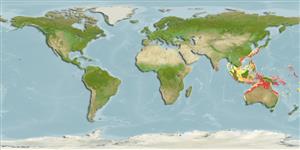>
Carangiformes (Jacks) >
Carangidae (Jacks and pompanos) > Caranginae
Etymology: Alepes: Greek, alepis, -idos = without scales (Ref. 45335).
Environment: milieu / climate zone / depth range / distribution range
Ecologia
marinhas demersal; intervalo de profundidade 5 - 80 m (Ref. 86942). Tropical
Western Central Pacific: endemic to northern Australia, from Exmouth Gulf, Western Australia to Wide Bay, Queensland.
Tamanho / Peso / Idade
Maturity: Lm ? range ? - ? cm
Max length : 29.5 cm TL macho/indeterminado; (Ref. 9894)
Espinhos dorsais (total): 8; Raios dorsais (total): 24-26; Espinhos anais 3; Raios anais : 20 - 22; Vértebras: 24. This species is distinguished by the following characters: adipose eyelid well developed on posterior half of the eye only; upper jaw narrowly rounded posteriorly, with supramaxilla relatively small without an anterior spine-like extension; gill rakers (including rudiments) 8-10 + 18-21 = 27-30. Colour in life green to bluish green above, silvery to white below, a diffuse dusky blotch on margin of opercle, not bordered above by a white spot; interradial membranes of spinous dorsal fin hyaline to dusky; spinous and second dorsal, anal, and caudal fins dusky yellow, with anterior rays of second dorsal and anal fins often with white tips; caudal-fin lobes often with dark tips; pelvic fins white and pectoral fins hyaline; juveniles with 7 dark bands on body (Ref. 9894).
Adults occur in inshore waters of the continental shelf (Ref. 75154). Feeds primarily on small invertebrates, primarily microscopic crustaceans and molluscs. Caught mainly on hook-and-line (Ref. 9894).
Ciclo de vida ou comportamento de acasalamento
Maturidade | Reprodução | Desova | Ovos | Fecundidade | Larvas
Smith-Vaniz, W.F., 1999. Carangidae. Jacks and scads (also trevallies, queenfishes, runners, amberjacks, pilotfishes, pampanos, etc.). p. 2659-2756. In K.E. Carpenter and V.H. Niem (eds.) FAO species identification guide for fishery purposes. The living marine resources of the Western Central Pacific. Vol. 4. Bony fishes part 2 (Mugilidae to Carangidae). Rome, FAO. 2069-2790 p. (Ref. 9894)
Status na Lista Vermelha da UICN (Ref. 130435)
Ameaça para os humanos
Harmless
Uso pelos humanos
Pescarias: espécies comerciais
Mais informação
Nomes comunsSinônimosMetabolismoPredadoresEcotoxicologiaReproduçãoMaturidadeDesovaAgregação de desovaFecundidadeOvosDesenvolvimento dos ovos
Idade/TamanhoCrescimentoPeso-comprimentoComprimento-comprimentoFrequências de comprimentoMorfometriaMorfologiaLarvasDinâmica larvalRecrutamentoAbundânciaBRUVS
ReferênciasAquaculturaPerfil para aquaculturaEstirpesGenéticaElectrophoresesHereditariedadeDoençasProcessamentoNutrientsConversão de massa
ColaboradoresFotosStamps, Coins Misc.SonsCiguateraVelocidadeTipo de nataçãoÁrea branquialOtólitosCérebrosVisão
Ferramentas
Relatórios especiais
Baixar XML
Fontes da internet
Estimates based on models
Preferred temperature (Ref.
123201): 24.5 - 28.7, mean 27.7 °C (based on 544 cells).
Índice de diversidade filogenética (Ref.
82804): PD
50 = 0.5312 [Uniqueness, from 0.5 = low to 2.0 = high].
Bayesian length-weight: a=0.01349 (0.00646 - 0.02815), b=2.96 (2.79 - 3.13), in cm total length, based on LWR estimates for this (Sub)family-body shape (Ref.
93245).
Nível Trófico (Ref.
69278): 3.5 ±0.5 se; based on size and trophs of closest relatives
Resiliência (Ref.
120179): Elevada, tempo mínimo de duplicação da população menor que 15 meses (Preliminary K or Fecundity.).
Fishing Vulnerability (Ref.
59153): Low vulnerability (20 of 100).
